Developing a Career Plan for Perioperative Nursing in NSW Health
VerifiedAdded on 2022/08/26
|5
|1299
|22
Report
AI Summary
This report presents a detailed career development plan for a student transitioning into perioperative nursing within the NSW Health system. The plan begins with a self-assessment, including a SWOT analysis to identify strengths (time management skills), weaknesses (impatience), opportunities (new skills), and threats (inability to learn). The student outlines a strategy for understanding the healthcare workforce, including characteristics, demands, and geographical distribution to enhance patient care. The plan focuses on understanding workforce characteristics, analyzing the demands of nursing professionals, and assessing geographical distribution to improve care strategies. The student aims to address mandatory training, CPD requirements, and WHS training. The report references several academic sources to support the development plan and discusses the importance of the GradStart program and Transition to Perioperative Practice (T2P) program offered by WSLHD. This plan provides a structured approach to clinical practice development, promoting workplace learning, and enhancing collaboration and communication to achieve career goals. The student will begin work in May 2020 in the perioperative services in the NSW Health public hospital.
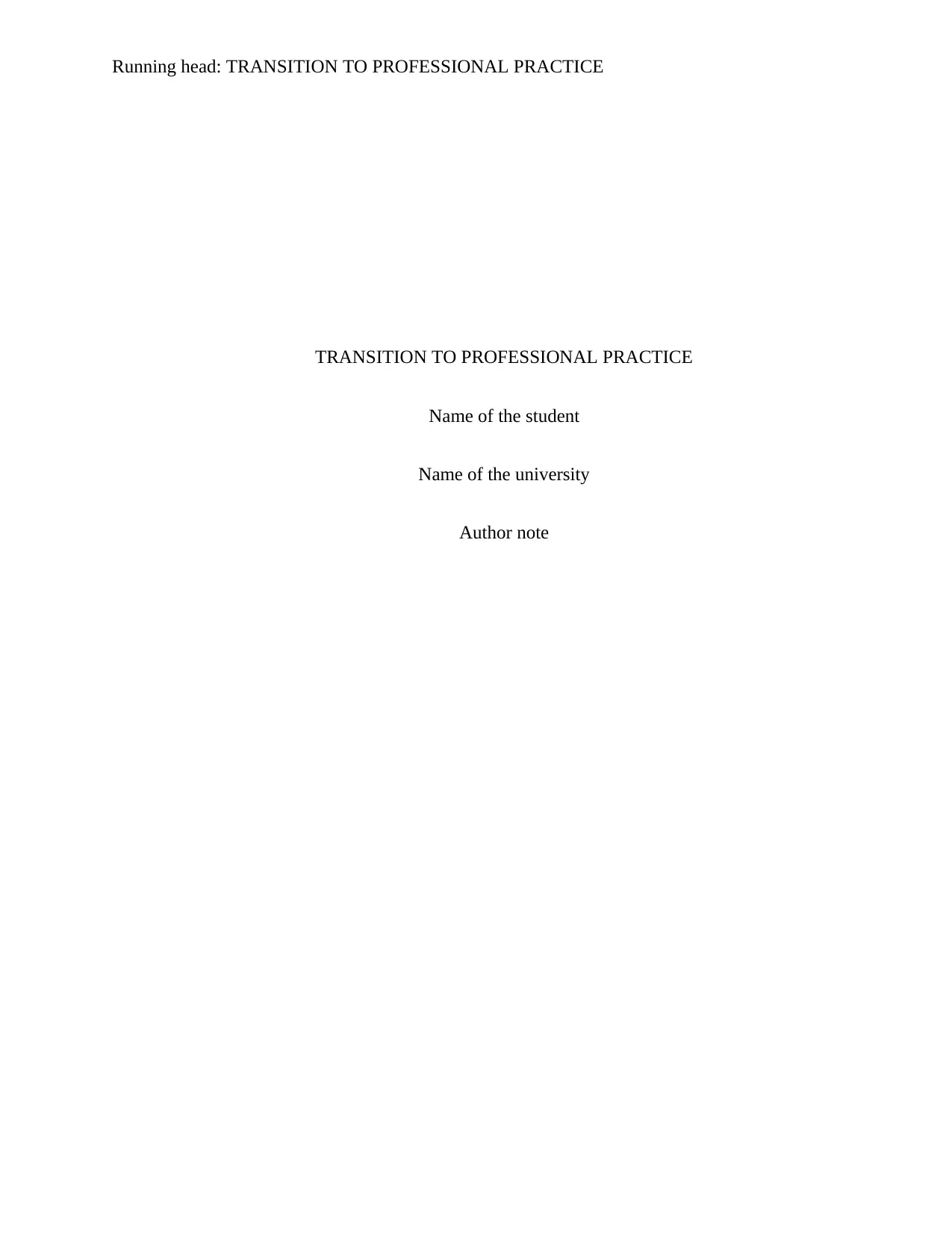
Running head: TRANSITION TO PROFESSIONAL PRACTICE
TRANSITION TO PROFESSIONAL PRACTICE
Name of the student
Name of the university
Author note
TRANSITION TO PROFESSIONAL PRACTICE
Name of the student
Name of the university
Author note
Paraphrase This Document
Need a fresh take? Get an instant paraphrase of this document with our AI Paraphraser
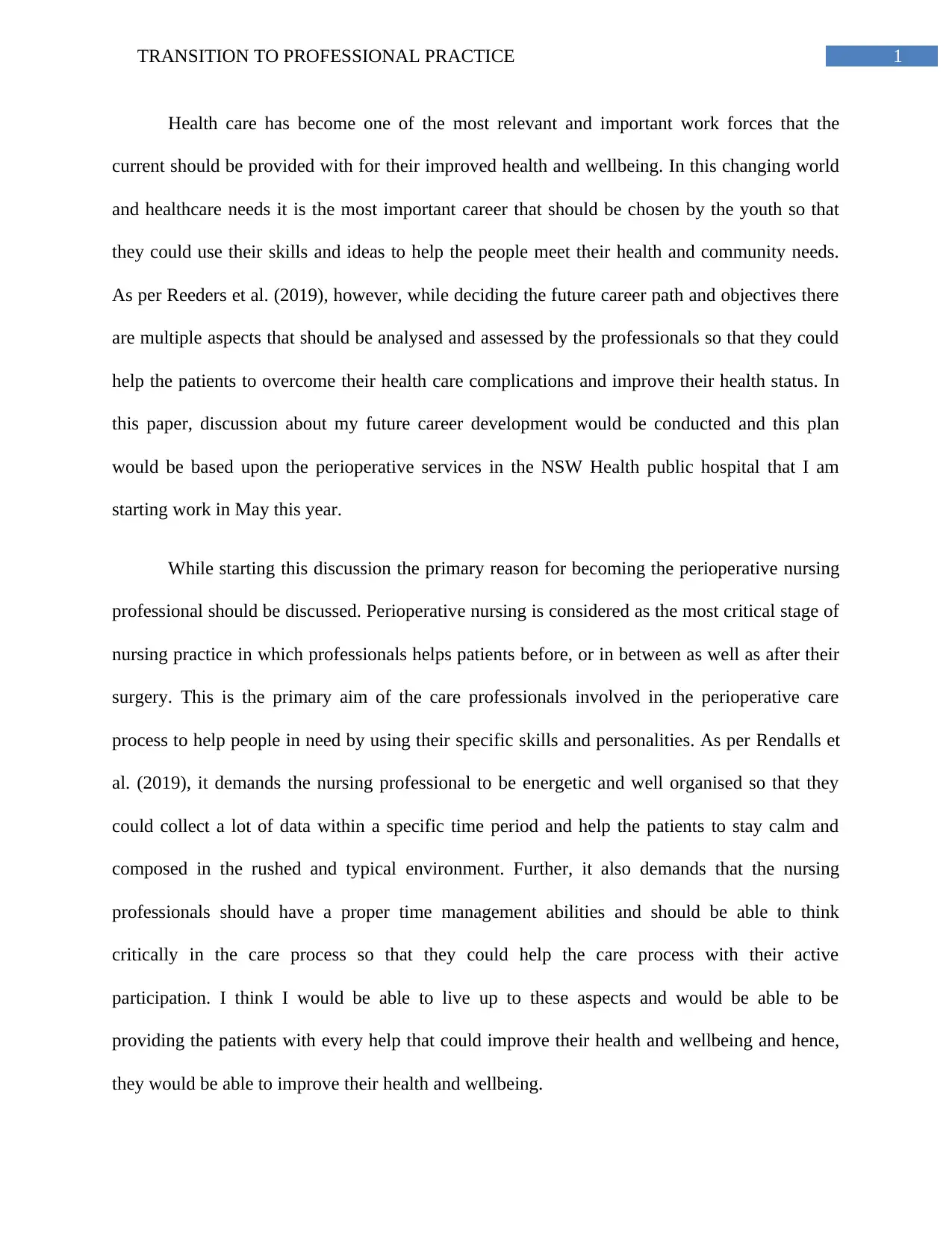
1TRANSITION TO PROFESSIONAL PRACTICE
Health care has become one of the most relevant and important work forces that the
current should be provided with for their improved health and wellbeing. In this changing world
and healthcare needs it is the most important career that should be chosen by the youth so that
they could use their skills and ideas to help the people meet their health and community needs.
As per Reeders et al. (2019), however, while deciding the future career path and objectives there
are multiple aspects that should be analysed and assessed by the professionals so that they could
help the patients to overcome their health care complications and improve their health status. In
this paper, discussion about my future career development would be conducted and this plan
would be based upon the perioperative services in the NSW Health public hospital that I am
starting work in May this year.
While starting this discussion the primary reason for becoming the perioperative nursing
professional should be discussed. Perioperative nursing is considered as the most critical stage of
nursing practice in which professionals helps patients before, or in between as well as after their
surgery. This is the primary aim of the care professionals involved in the perioperative care
process to help people in need by using their specific skills and personalities. As per Rendalls et
al. (2019), it demands the nursing professional to be energetic and well organised so that they
could collect a lot of data within a specific time period and help the patients to stay calm and
composed in the rushed and typical environment. Further, it also demands that the nursing
professionals should have a proper time management abilities and should be able to think
critically in the care process so that they could help the care process with their active
participation. I think I would be able to live up to these aspects and would be able to be
providing the patients with every help that could improve their health and wellbeing and hence,
they would be able to improve their health and wellbeing.
Health care has become one of the most relevant and important work forces that the
current should be provided with for their improved health and wellbeing. In this changing world
and healthcare needs it is the most important career that should be chosen by the youth so that
they could use their skills and ideas to help the people meet their health and community needs.
As per Reeders et al. (2019), however, while deciding the future career path and objectives there
are multiple aspects that should be analysed and assessed by the professionals so that they could
help the patients to overcome their health care complications and improve their health status. In
this paper, discussion about my future career development would be conducted and this plan
would be based upon the perioperative services in the NSW Health public hospital that I am
starting work in May this year.
While starting this discussion the primary reason for becoming the perioperative nursing
professional should be discussed. Perioperative nursing is considered as the most critical stage of
nursing practice in which professionals helps patients before, or in between as well as after their
surgery. This is the primary aim of the care professionals involved in the perioperative care
process to help people in need by using their specific skills and personalities. As per Rendalls et
al. (2019), it demands the nursing professional to be energetic and well organised so that they
could collect a lot of data within a specific time period and help the patients to stay calm and
composed in the rushed and typical environment. Further, it also demands that the nursing
professionals should have a proper time management abilities and should be able to think
critically in the care process so that they could help the care process with their active
participation. I think I would be able to live up to these aspects and would be able to be
providing the patients with every help that could improve their health and wellbeing and hence,
they would be able to improve their health and wellbeing.
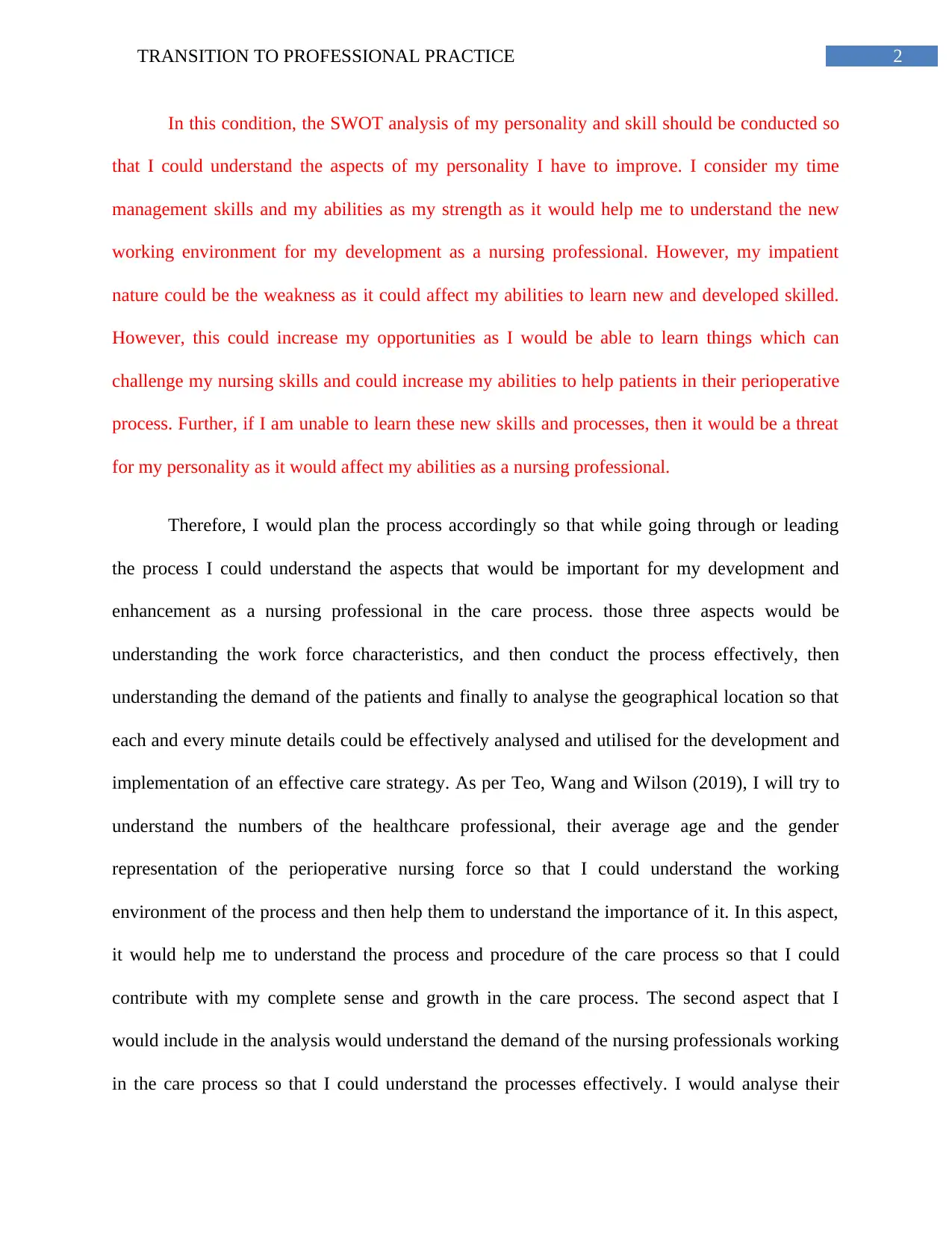
2TRANSITION TO PROFESSIONAL PRACTICE
In this condition, the SWOT analysis of my personality and skill should be conducted so
that I could understand the aspects of my personality I have to improve. I consider my time
management skills and my abilities as my strength as it would help me to understand the new
working environment for my development as a nursing professional. However, my impatient
nature could be the weakness as it could affect my abilities to learn new and developed skilled.
However, this could increase my opportunities as I would be able to learn things which can
challenge my nursing skills and could increase my abilities to help patients in their perioperative
process. Further, if I am unable to learn these new skills and processes, then it would be a threat
for my personality as it would affect my abilities as a nursing professional.
Therefore, I would plan the process accordingly so that while going through or leading
the process I could understand the aspects that would be important for my development and
enhancement as a nursing professional in the care process. those three aspects would be
understanding the work force characteristics, and then conduct the process effectively, then
understanding the demand of the patients and finally to analyse the geographical location so that
each and every minute details could be effectively analysed and utilised for the development and
implementation of an effective care strategy. As per Teo, Wang and Wilson (2019), I will try to
understand the numbers of the healthcare professional, their average age and the gender
representation of the perioperative nursing force so that I could understand the working
environment of the process and then help them to understand the importance of it. In this aspect,
it would help me to understand the process and procedure of the care process so that I could
contribute with my complete sense and growth in the care process. The second aspect that I
would include in the analysis would understand the demand of the nursing professionals working
in the care process so that I could understand the processes effectively. I would analyse their
In this condition, the SWOT analysis of my personality and skill should be conducted so
that I could understand the aspects of my personality I have to improve. I consider my time
management skills and my abilities as my strength as it would help me to understand the new
working environment for my development as a nursing professional. However, my impatient
nature could be the weakness as it could affect my abilities to learn new and developed skilled.
However, this could increase my opportunities as I would be able to learn things which can
challenge my nursing skills and could increase my abilities to help patients in their perioperative
process. Further, if I am unable to learn these new skills and processes, then it would be a threat
for my personality as it would affect my abilities as a nursing professional.
Therefore, I would plan the process accordingly so that while going through or leading
the process I could understand the aspects that would be important for my development and
enhancement as a nursing professional in the care process. those three aspects would be
understanding the work force characteristics, and then conduct the process effectively, then
understanding the demand of the patients and finally to analyse the geographical location so that
each and every minute details could be effectively analysed and utilised for the development and
implementation of an effective care strategy. As per Teo, Wang and Wilson (2019), I will try to
understand the numbers of the healthcare professional, their average age and the gender
representation of the perioperative nursing force so that I could understand the working
environment of the process and then help them to understand the importance of it. In this aspect,
it would help me to understand the process and procedure of the care process so that I could
contribute with my complete sense and growth in the care process. The second aspect that I
would include in the analysis would understand the demand of the nursing professionals working
in the care process so that I could understand the processes effectively. I would analyse their
⊘ This is a preview!⊘
Do you want full access?
Subscribe today to unlock all pages.

Trusted by 1+ million students worldwide
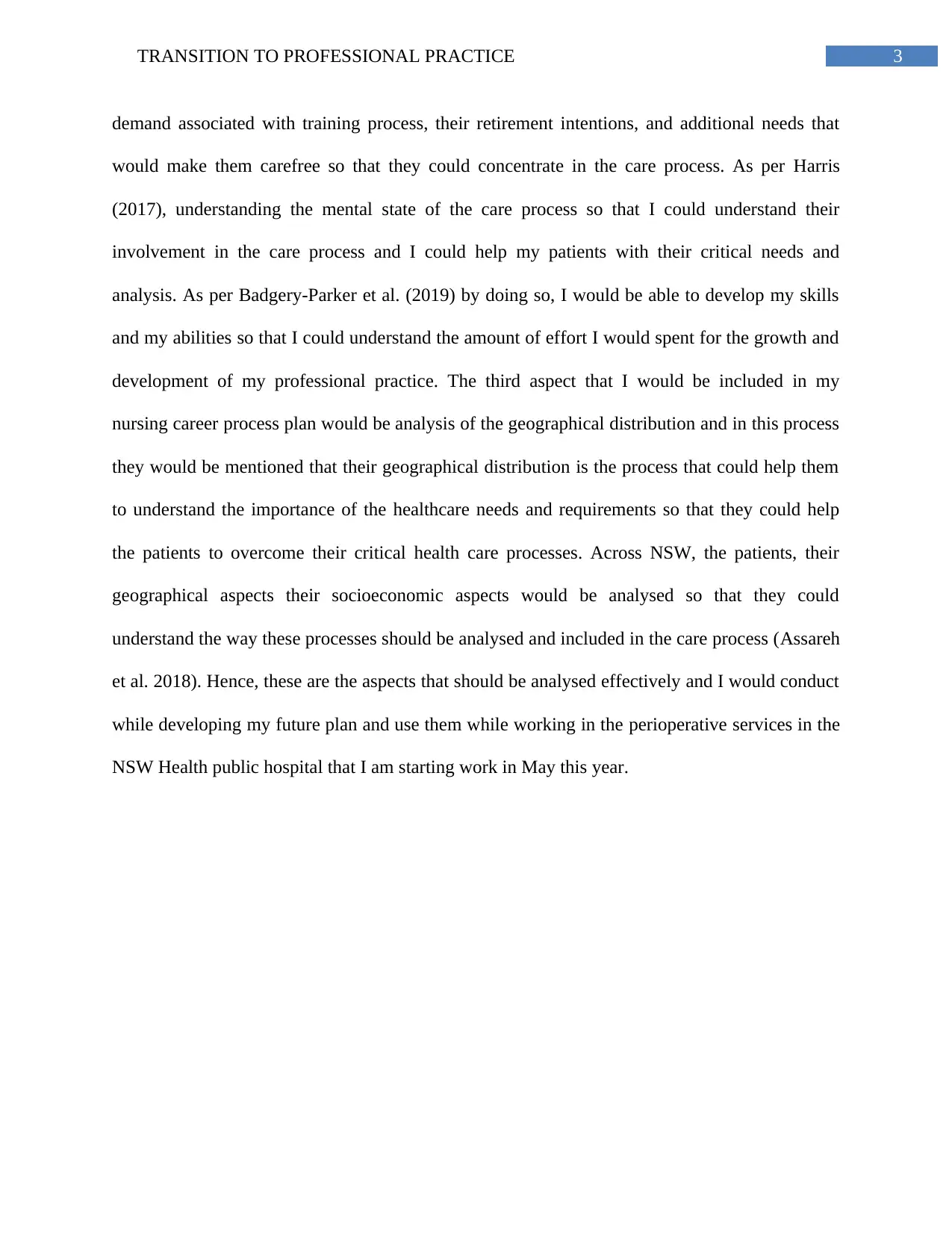
3TRANSITION TO PROFESSIONAL PRACTICE
demand associated with training process, their retirement intentions, and additional needs that
would make them carefree so that they could concentrate in the care process. As per Harris
(2017), understanding the mental state of the care process so that I could understand their
involvement in the care process and I could help my patients with their critical needs and
analysis. As per Badgery-Parker et al. (2019) by doing so, I would be able to develop my skills
and my abilities so that I could understand the amount of effort I would spent for the growth and
development of my professional practice. The third aspect that I would be included in my
nursing career process plan would be analysis of the geographical distribution and in this process
they would be mentioned that their geographical distribution is the process that could help them
to understand the importance of the healthcare needs and requirements so that they could help
the patients to overcome their critical health care processes. Across NSW, the patients, their
geographical aspects their socioeconomic aspects would be analysed so that they could
understand the way these processes should be analysed and included in the care process (Assareh
et al. 2018). Hence, these are the aspects that should be analysed effectively and I would conduct
while developing my future plan and use them while working in the perioperative services in the
NSW Health public hospital that I am starting work in May this year.
demand associated with training process, their retirement intentions, and additional needs that
would make them carefree so that they could concentrate in the care process. As per Harris
(2017), understanding the mental state of the care process so that I could understand their
involvement in the care process and I could help my patients with their critical needs and
analysis. As per Badgery-Parker et al. (2019) by doing so, I would be able to develop my skills
and my abilities so that I could understand the amount of effort I would spent for the growth and
development of my professional practice. The third aspect that I would be included in my
nursing career process plan would be analysis of the geographical distribution and in this process
they would be mentioned that their geographical distribution is the process that could help them
to understand the importance of the healthcare needs and requirements so that they could help
the patients to overcome their critical health care processes. Across NSW, the patients, their
geographical aspects their socioeconomic aspects would be analysed so that they could
understand the way these processes should be analysed and included in the care process (Assareh
et al. 2018). Hence, these are the aspects that should be analysed effectively and I would conduct
while developing my future plan and use them while working in the perioperative services in the
NSW Health public hospital that I am starting work in May this year.
Paraphrase This Document
Need a fresh take? Get an instant paraphrase of this document with our AI Paraphraser
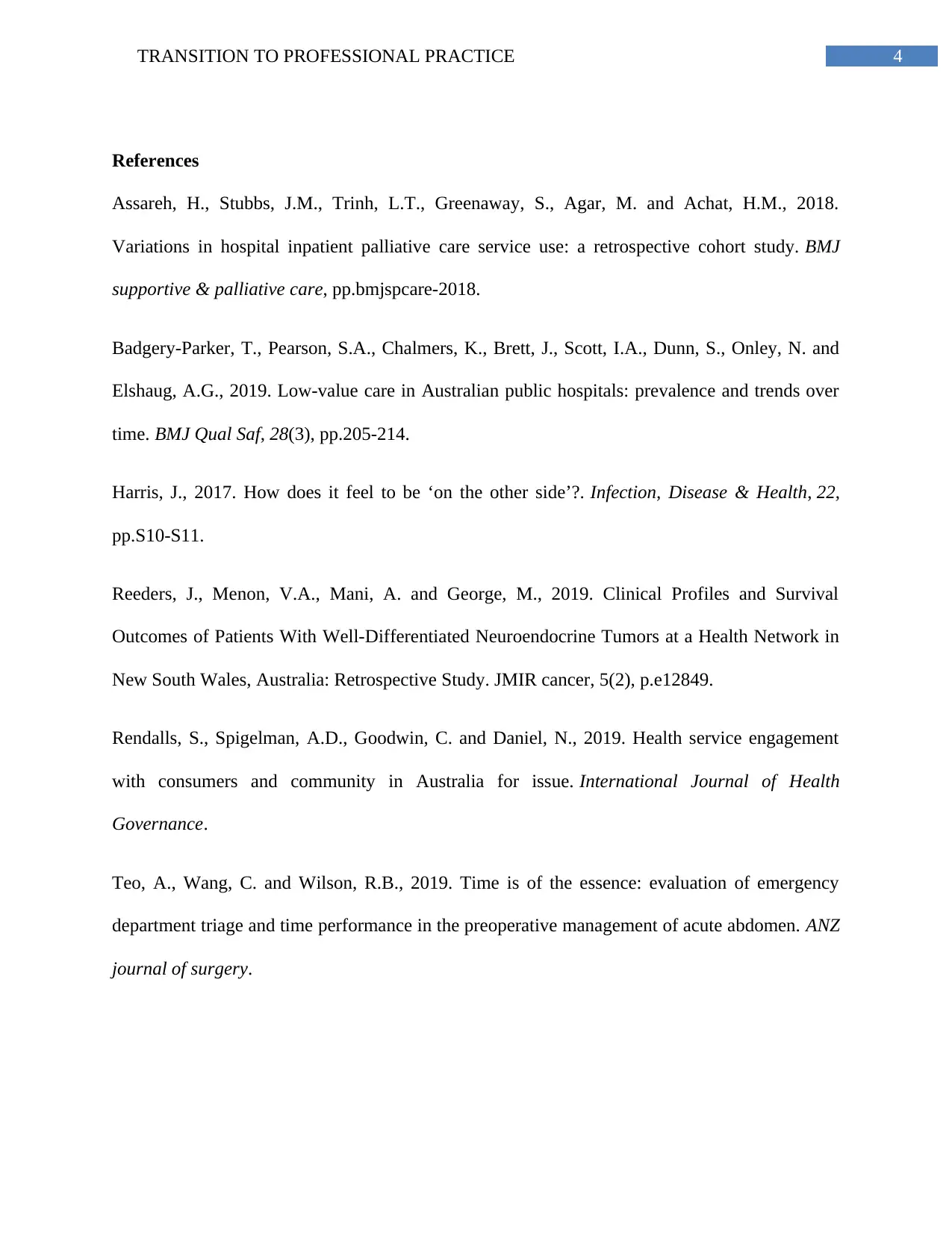
4TRANSITION TO PROFESSIONAL PRACTICE
References
Assareh, H., Stubbs, J.M., Trinh, L.T., Greenaway, S., Agar, M. and Achat, H.M., 2018.
Variations in hospital inpatient palliative care service use: a retrospective cohort study. BMJ
supportive & palliative care, pp.bmjspcare-2018.
Badgery-Parker, T., Pearson, S.A., Chalmers, K., Brett, J., Scott, I.A., Dunn, S., Onley, N. and
Elshaug, A.G., 2019. Low-value care in Australian public hospitals: prevalence and trends over
time. BMJ Qual Saf, 28(3), pp.205-214.
Harris, J., 2017. How does it feel to be ‘on the other side’?. Infection, Disease & Health, 22,
pp.S10-S11.
Reeders, J., Menon, V.A., Mani, A. and George, M., 2019. Clinical Profiles and Survival
Outcomes of Patients With Well-Differentiated Neuroendocrine Tumors at a Health Network in
New South Wales, Australia: Retrospective Study. JMIR cancer, 5(2), p.e12849.
Rendalls, S., Spigelman, A.D., Goodwin, C. and Daniel, N., 2019. Health service engagement
with consumers and community in Australia for issue. International Journal of Health
Governance.
Teo, A., Wang, C. and Wilson, R.B., 2019. Time is of the essence: evaluation of emergency
department triage and time performance in the preoperative management of acute abdomen. ANZ
journal of surgery.
References
Assareh, H., Stubbs, J.M., Trinh, L.T., Greenaway, S., Agar, M. and Achat, H.M., 2018.
Variations in hospital inpatient palliative care service use: a retrospective cohort study. BMJ
supportive & palliative care, pp.bmjspcare-2018.
Badgery-Parker, T., Pearson, S.A., Chalmers, K., Brett, J., Scott, I.A., Dunn, S., Onley, N. and
Elshaug, A.G., 2019. Low-value care in Australian public hospitals: prevalence and trends over
time. BMJ Qual Saf, 28(3), pp.205-214.
Harris, J., 2017. How does it feel to be ‘on the other side’?. Infection, Disease & Health, 22,
pp.S10-S11.
Reeders, J., Menon, V.A., Mani, A. and George, M., 2019. Clinical Profiles and Survival
Outcomes of Patients With Well-Differentiated Neuroendocrine Tumors at a Health Network in
New South Wales, Australia: Retrospective Study. JMIR cancer, 5(2), p.e12849.
Rendalls, S., Spigelman, A.D., Goodwin, C. and Daniel, N., 2019. Health service engagement
with consumers and community in Australia for issue. International Journal of Health
Governance.
Teo, A., Wang, C. and Wilson, R.B., 2019. Time is of the essence: evaluation of emergency
department triage and time performance in the preoperative management of acute abdomen. ANZ
journal of surgery.
1 out of 5
Related Documents
Your All-in-One AI-Powered Toolkit for Academic Success.
+13062052269
info@desklib.com
Available 24*7 on WhatsApp / Email
![[object Object]](/_next/static/media/star-bottom.7253800d.svg)
Unlock your academic potential
Copyright © 2020–2025 A2Z Services. All Rights Reserved. Developed and managed by ZUCOL.





